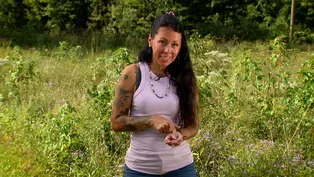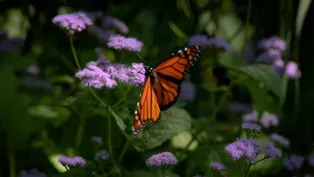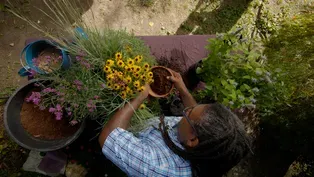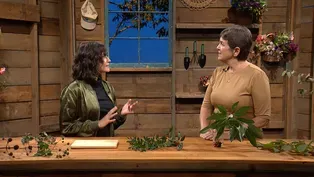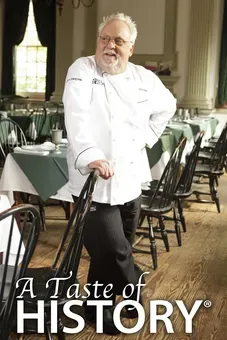Virginia Home Grown
Clippings: Native Plants
Clip: Season 23 Episode 7 | 26m 46sVideo has Closed Captions
Learn how native plants feed wildlife to create healthy ecosystems!
Peggy Singlemann learns about native food plants with Paul Cipriani from The Living Earth School. Dr. Robyn Puffenbarger meets Devin Floyd from the Center for Urban Habitats to discuss restoration of indigenous plant communities that have been suppressed by traditional landscaping. Serome Hamlin and Amyrose Foll share garden tips. Engage with us or watch full episodes at vpm.org/vhg.
Problems with Closed Captions? Closed Captioning Feedback
Problems with Closed Captions? Closed Captioning Feedback
Virginia Home Grown is a local public television program presented by VPM
Virginia Home Grown
Clippings: Native Plants
Clip: Season 23 Episode 7 | 26m 46sVideo has Closed Captions
Peggy Singlemann learns about native food plants with Paul Cipriani from The Living Earth School. Dr. Robyn Puffenbarger meets Devin Floyd from the Center for Urban Habitats to discuss restoration of indigenous plant communities that have been suppressed by traditional landscaping. Serome Hamlin and Amyrose Foll share garden tips. Engage with us or watch full episodes at vpm.org/vhg.
Problems with Closed Captions? Closed Captioning Feedback
How to Watch Virginia Home Grown
Virginia Home Grown is available to stream on pbs.org and the free PBS App, available on iPhone, Apple TV, Android TV, Android smartphones, Amazon Fire TV, Amazon Fire Tablet, Roku, Samsung Smart TV, and Vizio.
Providing Support for PBS.org
Learn Moreabout PBS online sponsorship>>Commonly we talk about planting milkweeds as a way to support monarch butterflies.
But what they really need is not just a milkweed plant in isolation, we have to plant it with all of the other species that it's evolved with over millions of years.
>>Up here on the right is some green briar.
Humans can eat the new growth at the tips, but the deer also love them and they'll browse on them all year round.
>>Well, you know, that plant is not highly regarded in the garden because it's got thorns even on the roots as well as the shoots.
>>Yeah, it's quite a formidable plant.
>>Yes it is, and I am so glad the deer enjoy it.
(Peggy chuckles) >>Mm, yeah!
>>Production funding for Virginia Home Grown is made possible by... (bright music) Welcome to Virginia Home Grown.
We love native plants.
And today our focus is on exploring their importance in the environment.
For example, including native plants in our landscapes, introduces us to the myriad of insects that support songbirds.
Let's join Dr. Robyn Puffenbarger at a private garden in Charlottesville to meet Devin Floyd from the Center for Urban Habitats and learn about converting lawns into native plant ecosystems.
Let's take a look.
>>We aim to replicate natural plant communities in our installations.
And we do that through use of rigorous data collection and we look at that data and use it to figure out what ecosystems would be most likely to occur on a site and attempt to restore them.
Supporting pollinators is another thing.
And so a great way that we can do that is by ripping up our lawns and putting in native ecosystems like these ones right here.
We're mimicking natural ecosystems here.
This is not a butterfly garden or anything like that.
This is a native ecosystem restoration and we do that in the small scale in the home landscape and it makes a big difference.
>>I would've called this a rain garden but my understanding is it's so much more.
>>In the wild, we happen to see settings like this in natural habitats and it turns out they function a lot better than our traditional rain gardens.
Oftentimes when we're doing research and we're documenting natural systems, we find divots and swales in upland landscapes and if they happen to be full sun, those spots support so much diversity in the plants and they're little patch prairies and we make lists of species that we note there and that's how we know what to plant in these rain gardens that are trying to mimic natural habitat and support wildlife.
>>When I've been doing plantings and converting lawn into what I'm hoping is more like a native pollinator supporting garden, I've probably not been doing what I see here.
I've been smothering grass, planting a few of my native favorites, and then hoping they'll fill in but then I've got a mulch area that I have to spend a lot of time weeding.
So how did y'all plant this?
>>Well, site prep is very important and there are a few really good ways to do it.
The most important thing is to get rid of the existing seed bank.
The way that we do this most often is we strip the sod off and include about an inch of soil with that.
Another way is to smother the ground with cardboard, perhaps with a deep layer of mulch on top of the cardboard.
Takes a lot more time, but it works.
And a new practice that is kind of new into people's awareness is to use small scale prescribed fires to set the tone of the site.
>>Removing those unwanted seeds, the fire is really gonna get after that.
>>Yeah, it also forces germination quickly so you can see the full extent of your problem.
It won't remain lurking in your garden for two years.
You can go ahead and get rid of the problem right away, get those weeds out as they germinate.
But the fire has the effect of taking the plant material and turning it into magnesium and calcium and other cations and putting those back into the soil.
And that has a powerful impact for the plants that you're about to put in.
>>Wow.
>>Yeah.
>>So once the site has been prepped, you've planted the plants, they're growing now, what kind of ecosystem services is this patch gonna provide?
>>The primary service is definitely in the service of supporting biodiversity at the locality.
You're making a node of resilience that kind of echoes out through your neighborhood and beyond.
It just contributes to overall conservation and everybody can do that, even if it's something really tiny, can have an impact.
>>This site looks gorgeous.
There's great texture and differences in heights.
So tell us about the plants that are actually here in this site.
>>This time of the year we're seeing purple, yellow, and white, and that's because we have Black-eyed Susan's, like this, and Orange Coneflower down there and also Goldenrods, that Gray Goldenrod really lighting things up with gold.
But we also have lavenders and purples coming from Blue Mistflower, but also Great Blue Lobelia, those are some of the things we're seeing.
And then we've got these elegant grasses that kind of form a matrix between them.
Upland Bentgrass is in full bloom right now and it's really beautiful.
Bottle Brush Grass is another one.
The white that you see in the background is Thoroughwart, there's also Bushy Aster that's just started to bloom.
It's making some whites and the Asters, Thoroughwarts, the Goldenrods, there's not just one species of each plant.
There's four or five of each of those types of plants.
And that's what we see in the wild.
And what we notice is when we mimic that, the insects are supported doubly, there's more density in the insects and there's more variety.
>>So I'm sure the homeowner is really excited and involved in this project.
Could we meet him?
>>Oh yes, absolutely.
>>Hi Gregg.
>>Hey Gregg.
>>Thanks so much for having us here to your gardens.
Can you tell us a little bit about the transition from lawn to native plants and how you've enjoyed this immense change?
>>Yes.
I frankly had no idea what all of this would be like.
So it has been so enjoyable to see the richness, the diversity, the wildness that comes with all of this.
Where we used to have sort of an ugly patch of yard, we now have something I love to just come out and be in and sit in and watch what's happening in there.
So it's really changed the whole experience.
>>Wow, so Devin, there's a lot going on in terms of the plant diversity over here, out of the "rain garden" and into more of a drier area.
What kinds of plants do we have over here?
>>Yeah, in this area we have plants that are adapted to shade and part sun and intermittently wet and dry.
Those would include Bluemist flower, River Oats, Smooth Blue Aster and Christmas Fern, White Snakeroot, things like that.
>>My understanding is there is support from local government agencies to do this kind of work because of the water quality issues.
How did that play into what happened here?
>>In a big way, so water was our initial issue.
This is inundated with water in heavy rains, so it'll just fill with water and stay here for three or four days.
So we were looking for a solution to that.
And as we approached Devin, he brought in this possibility that there's money available to do this.
So it was the local Soil and Water Conservation District that we connected with.
They have a program that offered 75% financing up to a certain level to be able to do this.
And so we could have not have done what we did at this level without that level of funding.
We didn't have the budget for that.
So we're thrilled that that funding's available and it has launched our beginnings into this.
>>I think many of us think about a garden as an aesthetic, pretty plants, looking nice, maybe some maintenance.
But I think y'all have a very different philosophy.
And would you try to describe that for us?
>>Yeah, I'm happy to share how I've grown into that because I too, I think, I wasn't that connected to plants because it was just what's pretty, but I think as part of this process, there's a whole different way of looking at it.
What has excited me is we're not just planting plants anymore, but we're actually enriching the ecosystem around our house and that I find meaningful and that I want to expand on here.
So I'm a full convert in seeing this different way of holding plants and in our own place that we live and land that we can control to do that.
So I'm very excited about it.
>>That's great.
Yeah and for the homeowner that is beginning this process on their own, it means setting some goals that are a little bit different.
And usually it's aesthetics, straight lines, color, but if you come from restoration ecology, you start with biodiversity, plants and animals, fungi and everything.
And it just means taking some attention off of what we need and think about what the system and its plants and animals might need.
And then asking questions about what those things are and learning.
And it is a lifelong learning process which is part of the beauty of it.
>>Well, it's just a gorgeous landscape to have.
I'm so inspired by the density of planting and what I've learned about how to transform grass into a native planting with lots of biodiversity.
Thank you so much for hosting us today.
This has just been a wonderful learning experience.
>>Yeah, thank you for having me.
>>Thrilled to have you.
>>Thanks.
>>Yeah, thanks.
Presently the majority of our planted landscapes are composed of plants from Asia or Western Europe.
Reintroducing local native plants back into the landscape through plant substitutions and reducing the use of turf grass are important steps towards restoring our ecosystem.
Next, Amyrose Foll explains why fall is a good time for planting and shares what she is sowing in her wildflower meadow.
(light clacking sounds) >>I am in my meadow today and we have been curating a collection of native wild flowers here.
I'm broadcasting seeds, it's fall.
Fall is an excellent time to be planting wild flowers.
I have already some fire weed, some bluemist, goldenrod and in the back, there's boneset, a bevy of different kinds of native wild flowers here and the reason I'm doing it in the fall is because planting in the fall will give you about a two week headstart on blooms versus planting in the spring, and it really allows those seeds to settle over the wintertime.
Some seeds require a stratification process, which is a cold treatment, and they need certain hours of cold to be able to sprout and for those seeds to grow so this is the perfect time to do it.
You can buy already stratified seeds online or get them from other seed keepers, but this is great if you have them.
No muss, no fuss.
Mother nature will do the work for you.
Today we're adding some variety.
I have some goldenglow rudbeckia, I've got evening primrose and we've got bundle flowers.
We've got different heights, we've got different colors and different bloom times.
Our evening primrose will start blooming mid-summer, beginning of summer till fall, and they bloom at night.
They're native to this area.
We've got bundle flowers, they're white and shorter and then our goldenglow rudbeckia is gonna be taller and yellow and it will beautifully compliment this bluemist throughout this field that we planted previously and they are going to be perfect to put in now.
They'll settle into the ground and naturally sprout in the spring.
As a farmer, it gives me something to do a little farther into the season when the varieties that you can plant start to get smaller and smaller.
By getting these seeds in the ground now, you're gonna have an earlier food source, they'll be ready for those pollinators come spring.
It's also a great time to plant trees and shrubs for that spring bloom, so I encourage you to try this.
It's so satisfying and it gets you out in the garden farther into the season.
Even a small patch of wildflowers can make a difference for wildlife in your neighborhood.
I've been working on my meadow for a few years because every little bit helps to reconnect the built environment with the natural environment.
And now I travel to Mint Springs Valley Park in Crozet to meet Paul Cipriani from the Living Earth School to talk about native plants that provide food for people and wildlife.
>>Paul, when most people think of taking a walk in the woods, they just think of that they're gonna be able to relax and have this wonderful experience, but your experience of a walk in the woods is very different than that, so explain it to us.
>>Yeah, so when I'm out in the woods, there's multiple layers to my surroundings.
When I first started going out in the woods, I grew up in the suburbs, so I was used to lawns and parks and things like that, but as I started becoming more aware of everything that was out there from the animals to the plants, to even the rocks and the soil itself, my awareness started to open up and plants is one of those things that it's really hard for people to start to see.
Birds, it's pretty easy, everyone knows- >>Correct, different colors that fly around.
>>Yeah, exactly.
>>Plants are all green.
>>Yeah, it looks like just one big curtain of green out there, but the more you look, the closer you look, there's a lot out there to really learn about.
>>And there's so many facets to learn about too and to understand how important plants are to the wildlife in the woods.
Paul, I've never heard of the Living Earth School.
Could you please tell us about it?
>>Yeah, it's a school based out of Charlottesville, Virginia, and we offer programs to youth as well as adults.
We have homeschool programs throughout the year.
We also have summer camps that are pretty well known in the area, so we teach naturalist skills and survival skills.
>>That's fascinating.
Do you have a lot of participants?
>>We do, and the numbers keep growing.
In fact, since the pandemic, people have been really trying to get outside and it's really opened the doors for them to learn more about their surroundings.
>>That's fantastic.
I'm so glad there's a way for people to learn more about our outdoors, so thank you.
>>Yeah.
>>There's so much plants provide for us, even down to this persimmon tree.
Can you tell us more about it?
>>Well, the American persimmon has these beautiful orange fruits that it gets a little later in the year.
Right now, it's covered in the fruits.
They're green, but you wouldn't wanna take a bite out of them right now 'cause they're so astringent, and even when they start to turn a little bit of orange, it's tempting to take a bite out of them, but you really have to wait.
However, when they are ripe, they're delicious.
They're very sweet, they're easy to dehydrate, and they're also good forage for all of the animals out there, the raccoons, the opossums.
In fact, sometimes it's hard to get to them before the critters do, but it's a very important food source for a lot of the wildlife.
>>And when you say ripe, there is a certain time after we've had a good cold snap the starches will convert to sugars, and even the animals know that.
>>Yeah.
>>If you want some, you've gotta be right Johnny on the spot.
Yep.
>>Yep, the fruit will even start to wrinkle a little bit and that's another good indicator that you're on the right track, you're at the right time.
>>Yes, do we have any fruit to show?
>>Yeah, we picked up a couple here.
This one is, this is what most of the fruit look like right now.
This one has that orange color.
That pretty characteristic of it.
>>Very tempting.
>>It feels soft, I wanna pop it in my mouth, but I know better because I've been tricked like many other folks to take a taste test of the unripe persimmons.
Kind of a rite of passage, but it's something you could avoid if you want to, you know, just take our word for it.
>>Yes.
Wait for that good cold frost and then go out there.
What else do you see around us that kind of pops out as something that's beneficial?
>>I mean, there's things like wild grape growing in the thicket right over here.
There's pine trees, which every single pine tree can be used in some sort of survival situation, even as far as wild food goes.
There's a black walnut tree, which is actually pretty common in the area and they're all throughout most people's neighborhoods and I'm sure most people know their kids come back with their hands all dyed brown from playing with the husks, but there's edible quality to it as well.
In fact, I've seen bags of hulled black walnuts sold in the grocery stores for exorbitant amounts of money, and yet they're just, they're littering people's yards and they rake 'em up and bag 'em and send them off.
>>Yes, I think they're smart to capitalize on that.
>>Yeah, exactly.
>>It's so interesting to know all the plants around us that have, I'll say plants with a purpose, but are there other areas with plants for us to see?
>>Yeah, there's plenty of other areas.
Would you like to go take a look?
>>Sure, I'd love to, yes.
Well, Paul, where'd you pick that up?
>>Well, I found this cattail down by the edge of the pond.
It's one of my favorite survival plants.
It's got utilitarian purposes, such as thatching and insulation, but it's also got some edible qualities.
Right now, the plant's putting all its energy down into the roots.
>>Right, 'cause it's fall.
>>Yeah.
>>Plants are doing that.
>>These roots are full of starch, so all winter long, even when the greens go away, if you know where to dig 'em, you have access to carbohydrates, which can be kind of rare out in the woods.
>>Particularly a lot of protein, but few carbohydrates.
>>Yes.
>>Yes.
So it makes a tea, right?
>>It's something that you can take the starches from the root and use those starches in some sort of baked good or porridge.
However, there are roots that can be made into tea, such as in the sassafras tree.
>>A favorite of mine, yes.
>>Yeah, the bark of the roots gives this like beautiful reddish-orange tea that's reminiscent of root beer, and if you sweeten it and add a little bit of sparkling water, it almost tastes like the soda itself.
>>Interesting.
You know, you mentioned a reddish-orange color because this plant turns red-orange in the fall, making it beautiful for the landscape.
>>Yeah, definitely, it's something that would be wonderful to plant around your house, for sure.
>>Yeah, my kids always called this either the mitten tree or the dinosaur tree 'cause the leaves are either in the shape of a mitten or a dinosaur.
>>Yeah, those very distinct lobes make it a easy tree to identify.
>>Very easy.
>>There's a few more things down the trail.
Would you like to check it out?
>>I'd love to.
>>All right.
Up here on the right is some green briar.
>>Okay.
>>It's a vine that's covered in thorns, but on the very ends of the stems, they get these shoots of new growth that are really delicious.
>>Oh, really?
I didn't know you could eat those.
>>Yeah, they're really good.
They're very tender.
They just snap off and you can cook them up.
They're also really good forage for deer and other wildlife.
>>As a gardener that that plant is not a favorite because even the roots have thorns on them.
>>Yes.
>>Making it quite a challenge.
>>It's a very formidable plant.
>>It is very formidable, and you know, just because it's native, doesn't mean it's a great plant for the garden.
>>Exactly.
>>But I'm glad the deer like it.
(laughs) >>Yeah.
>>You've got some great plants here.
Big, beautiful alders and gorgeous witch-hazels.
What else do you have growing along here?
>>Up here on the right, there's a black locust tree.
>>Oh, I love black locust, but again, it's a very thorny native plant.
>>It is, it's interesting in it's use around planting so it can fix nitrogen in the soil, which is a nutrient that other plants need.
>>Very important, yes.
>>Yeah, and over here we've got this spice bush.
>>Oh, I'm a spice bush fan.
I love the fragrance of the leaves.
It's a super easy way to identify this very common green plant, we'll call it.
>>Right, and this time of the year, the berries are all turning red so they're quite beautiful.
>>But what can you use spice bush for?
>>Well, spice bush is good for teas.
You can use the leaves, or even the stems in the wintertime when the leaves are gone, and the berries can be dried and ground into a powder and used as like an allspice replacer.
>>Oh, a nice flavor, wonderful.
You know, as we've taken this walk and you've been able to point out plants, it's really helpful to show people that while they walk through woods, they're walking by a bunch of green plants, but so many of 'em have attributes that can be used for so many different purposes so I thank you for taking the time to do this.
>>Yeah, you're welcome.
I hope we have removed the curtain of green by encouraging you to look more closely at different plants and to value the role they play in our environment.
Next Serome Hamlin has a tip on how to feed pollinators.
No matter the size of your outdoor space.
you can create a container garden full of native plants for either sun or shade.
(upbeat music) >>Throughout the years, we have learned the importance of using natives in our landscape.
Now, more and more people are moving onto smaller properties and have smaller landscapes to work with.
But did you know that you can still benefit the ecology by providing native plants in a container?
I would be working from back to front using the thriller, filler, spiller method.
First, I'm gonna use this Veronia because this is gonna be one of the tallest plants.
Now to use as a filler, I've got Rudbeckia.
Now we're really, really gonna pack this container but it will be okay.
Next season, if it starts getting too full, then you can always divide and spread the wealth.
Now it look nice with some grasses.
So this is the little bluestem.
We can add that right in.
I think I wanna add one more.
The little bluestem, squeeze 'em in there.
So it's starting to look pretty full already.
And now, for our spiller here, I have a aster.
This one is called Snow Flurry.
Neat thing about this little aster is that it only gets about eight inches tall, so it will work perfectly for the front.
Let's go ahead and get this in place here.
Gonna make a little more space because I want to add in one more thing.
And this is this Callirhoe here.
Now I have added in different things to have different interests so the pollinators will have something to go for throughout the season.
This is in place now.
I think we are all set.
So I just need to top dress some soil in the bare spots here.
And then one other important thing, always remember to water your containers right after you're done putting them together.
Give those roots a drink.
I hope everyone will give this a try.
'Cause even the smallest garden make a big difference in the environment so you can go out and do this too.
Go out, get some native plants and put together a beautiful mixed planting.
Trust me, the pollinators will find it.
Providing food to pollinators year round is very important to their survival.
They also need places to overwinter.
You can support them by leaving dried stalks and stems in place through the cold winter months, as well as leaves in the garden.
I've enjoyed digging deeper into the roles of native plants in the ecosystem.
I hope you will find ways to integrate more into your garden and landscape.
See you soon.
And until then, remember gardening is for everyone.
We are all growing and learning together.
(light clacking sounds) There are several different pests that can come in and take over the garden.
One of them are squirrels.
Anita wants to know, does dryer sheets actually work to repel squirrels?
Yes, Anita.
It's been scientifically proven that squirrels do not like the smell of mint and even dryer sheets.
So you can take some, put them around your garden bed, stick them down with a stick in the ground and go from there.
Happy growing, Anita.
>>Production funding for Virginia Home Grown is made possible by... (bright music) (bright tone)
Video has Closed Captions
Fall wildflower seeds bring early spring color (2m 19s)
Video has Closed Captions
Remove lawn to restore beneficial plant communities (8m 49s)
Video has Closed Captions
Discover native plants to feed people and wildlife (7m 49s)
Native Plants for the Landscape
Video has Closed Captions
Discover native plants for the home landscape (6m 19s)
Providing Support for PBS.org
Learn Moreabout PBS online sponsorshipSupport for PBS provided by:
Virginia Home Grown is a local public television program presented by VPM
